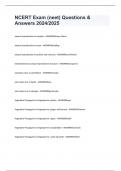NCERT Exam (neet) Questions & Answers 2024/2025
asexual reproduction in amoeba - ANSWERSbinary fission
asexual reproduction in yeast - ANSWERSbudding
asexual reproduction in protists and moneras - ANSWERScell division
chlamydomonas asexual reproduction structure - ANSWERSzoospores
asexrepro struc in penicillium - ANSWERSconidia
asex repro stuc in hydra - ANSWERSbuds
asex repro truc in sponges - ANSWERSgemmules
Vegetative Propagules in Angiosperms- potato - ANSWERSeyes
Vegetative Propagules in Angiosperms- ginger and banana - ANSWERSrhizome
Vegetative Propagules in Angiosperms- agave - ANSWERSbulbil
Vegetative Propagules in Angiosperms- bryophyllym - ANSWERSleaf buds
Vegetative Propagules in Angiosperms- water hyacinth - ANSWERSoffset Oestrus cycle - ANSWERStiger, cow, sheep, rat, deer, dog
menstrual cycle - ANSWERSmonkey, ape, human
monoecious/bisexual plants - ANSWERScucurbits, coconut, chara
dioecious/unisexual plants - ANSWERSpapaya, date palm, marchantia
bisexual animals (hermaphrodite) - ANSWERSearthworm, sponge, tapeworm, leech
unisexual animals - ANSWERScockroach
parthenogenesis - ANSWERSRotifers, honeybees, some lizards, birds (Turkey)
Most aquatic organisms - Majority of algae and fishes as well as amphibians exhibit - ANSWERSexternal fertilization
internal fertilization animals - ANSWERSfungi, reptiles, birds, mammals
internal fertilization plants - ANSWERSbryophytes, pteridophytes, gymnosperms, angiosperms
Multicarpellary, Syncarpous pistil - ANSWERSpapaver
Multicarpellary, Apocarpus gynoecium - ANSWERSmichelia
Presence of one ovule in an ovary - ANSWERSwheat, paddy, mango
Presence of many ovules in an ovary - ANSWERSpapaya, watermelon, orchids autogamy - ANSWERSviola (common pansy), oxalis, commelina
abiotic agents of pollination - ANSWERSwind and water
Animals [Bees, Butterflies, beetles, wasp, ants, moths, birds (sunbird and humming
birds), bats, some primates(lemurs) and arboreal(tree- dwelling) rodents, reptiles (gecko lizard and garden lizard)] - ANSWERSbiotic pollination agents
pollination by animals - ANSWERSzoophily
pollination by wind - ANSWERSanemophily
pollination by insects - ANSWERSentomophily
pollination by water - ANSWERShydrophily
wind pollination in.. - ANSWERSgrasses (wheat and maize), gymnosperms
water pollination - ANSWERSalgae, bryophytes, pteridophytes, vallisneria, hydrilla (fresh water), zostera (marine water)
endosperms completely consumed by developing embryo before seed maturation - ANSWERSpea, groundnuts, beans
persistent endosperm - ANSWERSRice, Mustard, Wheat, Maize, castor, coconut
Albuminous seed - ANSWERSmonocot:Wheat, maize, barley
dicot:castor
Non-Albuminous seed - ANSWERSPea, beans, groundnut (dicots) most fruits are... - ANSWERStrue fruits (ex: mango, tomato)
false fruits - ANSWERSapple, strawberry, cashew
parthenocarpic fruits - ANSWERSbanana
The ability of some plant species to reproduce asexually through seeds without fertilization by a male gamete. - ANSWERSapomixis
development of fruit without seeds - ANSWERSparthenocarpy
Asexual reproduction in which females produce offspring from unfertilized eggs. - ANSWERSparthenogenesis
Polyembryony (one zygote to many embryos) - ANSWERScitrus fruits
hormones released during pregnancy by placenta - ANSWERShCG, hPL, Estrogens, Progestogens
hormones released during pregnancy by ovary - ANSWERSrelaxin
levels of estrogens, progestogens, cortisol, prolactin, thryoxine are increased in maternal blood during - ANSWERSpregnancy
Natural methods of contraception - ANSWERSPeriodic abstinence, Withdrawal or coitus interrupts, lactational amenorrhea
Barrier methods of contraception - ANSWERSCondoms, Diaphragms, cervical caps andvaults
Non-medicated - Lippes loop




